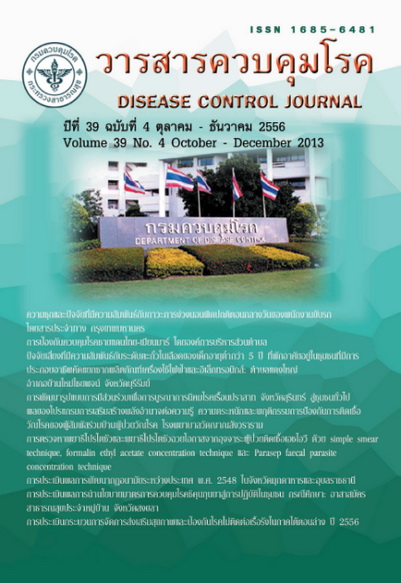ความชุกและปัจจัยที่มีความสัมพันธ์กับภาวะการง่วงนอนผิดปกติตอนกลางวัน ของพนักงานขับรถโดยสารประจำทาง กรุงเทพมหานคร
DOI:
https://doi.org/10.14456/dcj.2013.1คำสำคัญ:
ความชุก, ภาวะการง่วงนอนมากกว่าปกติตอนกลางวัน, พนักงานขับรถโดยสารประจำทางบทคัดย่อ
ภาวะการง่วงนอนมากกว่าปกติตอนกลางวันเป็นภาวะที่พบได้มาก ส่งผลให้เกิดความสูญเสีย มีความเสี่ยงทำให้เกิดอุบัติเหตุ การบาดเจ็บในงาน และมีความเชื่อมโยงกับการเกิดความผิดปกติของการนอนหลับ แต่ยังคงมีปัญหาในเรื่องของการวินิจฉัย ทำให้มีอุบัติการณ์ที่ต่ำกว่าความเป็นจริง ส่งผลให้ผู้ป่วยไม่ได้รับการรักษา การศึกษานี้จึงมีวัตถุประสงค์เพี่อศึกษาความชุกของภาวะการง่วงนอนมากกว่าปกติตอนกลางวันในพนักงานขับรถ โดยสารประจำทางขององค์การขนส่งมวลชนกรุงเทพมหานคร (ขสมก.) โดยใช้รูปแบบการศึกษาเชิงพรรณนา ณ จุดเวลาใดเวลาหนึ่ง กลุ่มตัวอย่างเป็นพนักงานขับรถโดยสารประจำทางสังกัด ขสมก. จำนวน 241 คน จากเขต การเดินรถที่ 1, 2 และ 8 ระหว่างเดือนมกราคม 2556 โดยการใช้แบบสอบถาม Epworth sleepiness scale ผลการศึกษาพบว่ามีผู้เข้าร่วมการศึกษาร้อยละ 83 อัตราความชุกของการเกิดภาวะการง่วงนอนมากกว่าปกติตอนกลางวันในพนักงานขับรถโดยสารประจำทาง ขสมก. เทำกับร้อยละ 86 คะแนนเฉลี่ย Epworth sleepiness score เทำกับ 12.68 ปัจจัยที่มีความสัมพันธ์กับการเกิดภาวะการง่วงนอนมากกว่าปกติตอนกลางวันในพนักงานขับรถโดยสาร ประจำทางขององค์การขนส่งมวลชนกรุงเทพมหานคร อย่างมีนัยสำคัญทางสถิติ (p<0.05) ได้แก่ ดัชนีมวลกาย การรับประทานยานอนหลับ การรับประทานยารักษาโรคประจำตัว การสูบบุหรี่ การดื่มสุรา การดื่มกาแฟ จำนวนวัน ทำงานต่อสัปดาห์ ช่วงเวลาทำงาน ชั่วโมงการนอนหลับในวันทำงาน ชั่วโมงการนอนหลับในวันหยุด การดื่นตอน กลางคนในวันทำงาน การดื่นตอนกลางคนในวันหยุด ท่าทางการนอนตะแคงขวาและซ้าย การนอนกรน ความดังของเสียงกรน การตื่นปัสสาวะ การนอนขากระตุก การนอนฝัน การศึกษานี้พบว่าความชุกของภาวะการง่วงนอนมากกว่าปกติตอนกลางวัน ในพนักงานขับรถโดยสารประจำทางขององค์การขนส่งมวลชนกรุงเทพมหานครสูงกว่าการศึกษาอื่นค่อนข้างมาก โดยปัจจัยที่มีความสัมพันธ์กับภาวะนี้สูงที่สุดคือ การดื่มสุรา และการสูบบุหรี่ ควรมีการรณรงค์ให้เลิกการบริโภคสุราและบุหรี่ รวมถึงการตรวจ คัดกรองภาวะการง่วงนอนมากกว่าปกติตอนกลางวันในพนักงานขับรถโดยสารประจำทาง ขสมก.
Downloads
เอกสารอ้างอิง
2. Roth T, Roehrs TA. Etiologies and sequelae of excessive daytime sleepiness. Clin Ther 1996; 18:562-76.
3. National Highway Traffic Safety Administration. Drowsy driving and automobile crashes [Internet], [cited 2012 June 25]. Available from: http://www.nhtsa.gov/ people/injury/drowsy_drivingl/Drowsy.html.
4. National Sleep Foundation. State of the states report on drownsy driving. [Internet] 2007. [cited 2012, June 25]; Available from: http://www.drowsydriving.org.
5. กลุ่มงานสารสนเทศฯ สำนักงานตำรวจแห่งชาติ. สถิติอุบัติเหตุจราจร ปีงบประมาณ 2554. [Internet] 2012. [สืบค้นเมื่อวันที่ 25 มิถุนายน 2555]. แหล่งข้อมูล URL: http://www.royalthaipolice.go.th/stat.htm.
6. International Classification of Sleep Disorders. Diagnosis and coding manual. Rochestor MN: American Academy of Sleep Medicine 2005.
7. Liu X, Uchiyama M, Kim K, Okawa M, Shibui K, Kudo Y, et al. Sleep loss and daytime sleepi¬ness in the general adult population of Japan. Psychiatry Res 2000;93:1-11.
8. Doi Y, Minowa M. Gender differences in ex¬cessive daytime sleepiness among Japanese workers. Soc Sci Med 2003;56:883-94.
9. Wu S, Wang R, Ma X, Zhao Y, Yan X, He J. Excessive daytime sleepiness assessed by the Epworth Sleepiness Scale and its association with health related quality of life: a population-based study in China. BMC Public Health 2012;12: 849.
10. จันทร์จิรา ความรู้. ปัจจัยคัดสรรที่สัมพันธ์กับความง่วงนอนในพนักงานขับรถโดยสารประจำทาง (วิทยานิพนธ์ปริญญามหาบัณฑิต) สาขาพยาบาลศาสตร์, คณะพยาบาลศาสตร์กรุงเทพมหานคร: จุฬาลงกรณ์มหาวิทยาลัย; 2548.
11. Banhiran W, Assanasen P, Nopmaneejumruslers C, Metheetrairut C. Epworth sleepiness scale in obstructive sleep disordered breathing: the reliability and validity of the Thai version. Sleep Breath 2011;15:571-7.
12. Murray WJ. A new method for measuring daytime sleepiness: the Epworth sleepiness scale. Sleep 1991;14:540-5.
13. Murray WJ. Reliability and factor analysis of Epworth sleepiness scale. Sleep 1992;15:376-81.
14. Alon AY, Barkoukis TJ. Review of sleep medicine, third ed. Philadelphia: Elsevier; 2012.
15. Guilleminault C, Brooks SN. Excessive daytime sleepiness: a challenge for the practising neurologist. Brain 2001;124(Pt 8):1482-91.
16. Mahmood M, Kushida CA. Excessive daytime sleepiness. Hand Clin Neurol 2011;99:825- 31.
17. Silvestri R. Arico I. Sleep disorsers. Sleep medicine. New York: Cambrige University Press; 2008. p.47-64.
18. Azarbarzin A, Moussavi z. Intra-subject variability of snoring sounds in relation to body position, sleep stage, and blood oxygen level. Med Biol Eng Comput. 2012. (Prepublished Manuscript).
ดาวน์โหลด
เผยแพร่แล้ว
รูปแบบการอ้างอิง
ฉบับ
ประเภทบทความ
สัญญาอนุญาต
บทความที่ลงพิมพ์ในวารสารควบคุมโรค ถือว่าเป็นผลงานทางวิชาการหรือการวิจัย และวิเคราะห์ตลอดจนเป็นความเห็นส่วนตัวของผู้เขียน ไม่ใช่ความเห็นของกรมควบคุมโรค ประเทศไทย หรือกองบรรณาธิการแต่ประการใด ผู้เขียนจำต้องรับผิดชอบต่อบทความของตน






